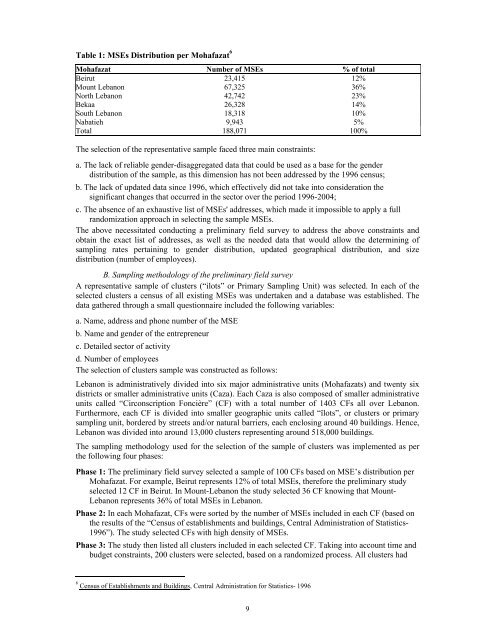MICRO AND SMALL ENTERPRISES IN LEBANON
MICRO AND SMALL ENTERPRISES IN LEBANON
MICRO AND SMALL ENTERPRISES IN LEBANON
You also want an ePaper? Increase the reach of your titles
YUMPU automatically turns print PDFs into web optimized ePapers that Google loves.
Table 1: MSEs Distribution per Mohafazat 6Mohafazat Number of MSEs % of totalBeirut 23,415 12%Mount Lebanon 67,325 36%North Lebanon 42,742 23%Bekaa 26,328 14%South Lebanon 18,318 10%Nabatieh 9,943 5%Total 188,071 100%The selection of the representative sample faced three main constraints:a. The lack of reliable gender-disaggregated data that could be used as a base for the genderdistribution of the sample, as this dimension has not been addressed by the 1996 census;b. The lack of updated data since 1996, which effectively did not take into consideration thesignificant changes that occurred in the sector over the period 1996-2004;c. The absence of an exhaustive list of MSEs' addresses, which made it impossible to apply a fullrandomization approach in selecting the sample MSEs.The above necessitated conducting a preliminary field survey to address the above constraints andobtain the exact list of addresses, as well as the needed data that would allow the determining ofsampling rates pertaining to gender distribution, updated geographical distribution, and sizedistribution (number of employees).B. Sampling methodology of the preliminary field surveyA representative sample of clusters (“ilots” or Primary Sampling Unit) was selected. In each of theselected clusters a census of all existing MSEs was undertaken and a database was established. Thedata gathered through a small questionnaire included the following variables:a. Name, address and phone number of the MSEb. Name and gender of the entrepreneurc. Detailed sector of activityd. Number of employeesThe selection of clusters sample was constructed as follows:Lebanon is administratively divided into six major administrative units (Mohafazats) and twenty sixdistricts or smaller administrative units (Caza). Each Caza is also composed of smaller administrativeunits called “Circonscription Foncière” (CF) with a total number of 1403 CFs all over Lebanon.Furthermore, each CF is divided into smaller geographic units called “îlots”, or clusters or primarysampling unit, bordered by streets and/or natural barriers, each enclosing around 40 buildings. Hence,Lebanon was divided into around 13,000 clusters representing around 518,000 buildings.The sampling methodology used for the selection of the sample of clusters was implemented as perthe following four phases:Phase 1: The preliminary field survey selected a sample of 100 CFs based on MSE’s distribution perMohafazat. For example, Beirut represents 12% of total MSEs, therefore the preliminary studyselected 12 CF in Beirut. In Mount-Lebanon the study selected 36 CF knowing that Mount-Lebanon represents 36% of total MSEs in Lebanon.Phase 2: In each Mohafazat, CFs were sorted by the number of MSEs included in each CF (based onthe results of the “Census of establishments and buildings, Central Administration of Statistics-1996”). The study selected CFs with high density of MSEs.Phase 3: The study then listed all clusters included in each selected CF. Taking into account time andbudget constraints, 200 clusters were selected, based on a randomized process. All clusters had6Census of Establishments and Buildings, Central Administration for Statistics- 19969
















